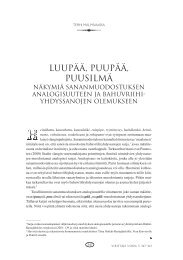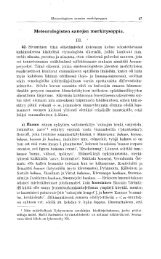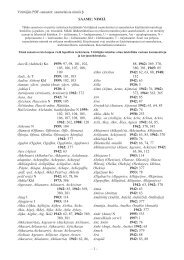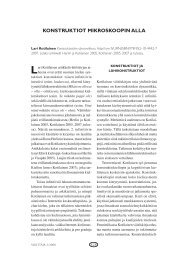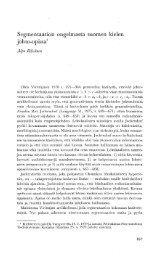pdf-tiedostona - Kotikielen Seura
pdf-tiedostona - Kotikielen Seura
pdf-tiedostona - Kotikielen Seura
You also want an ePaper? Increase the reach of your titles
YUMPU automatically turns print PDFs into web optimized ePapers that Google loves.
ERG. J<br />
(marked)'<br />
NOM. <<br />
(unmarked)<br />
The customary<br />
ergative systems<br />
^TRANSITIVE<br />
SUBJECT<br />
INTRANS. SUBJECT<br />
(agentive)<br />
INTRANSITIVE<br />
SUBJECT<br />
(non-agentive)<br />
OBJECT<br />
(non-agentive)<br />
Finnish<br />
TRANSITIVE<br />
SUBJECT<br />
INTRANS. SUBJECT<br />
(agentive)<br />
INTRANS. SUBJECT<br />
(non-agentive,<br />
non-existential)<br />
INTRANS SUBJECT<br />
(non-agentive, existential)<br />
: OBJECT<br />
(non-agentive)<br />
TERHO ITKONEN<br />
NOM.<br />
(unmarked)<br />
OBJECT<br />
> CASE:<br />
PART IT./<br />
ACC.<br />
(marked)<br />
The distribution of the subject and object cases in customary ergative systems and<br />
in Finnish. The size of the boxes roughly reflects the text frequencies; the shadowed<br />
areas indicate the marked cases (see 1.4.2). The thick horizontal line separates agentive<br />
use of the cases concerned (and the non-agentive use of a transitive subject, cf. 1.5.1)<br />
from the non-agentive use. It can be seen that the border line does not coincide with<br />
that of ergative and nominative nor (in Finnish) with that of nominative and partitive/<br />
accusative: the former remains above the line, the latter beneath it (cf. 1.4.3). The<br />
matter stands differently in »ideal» ergative systems, which have an ergative : nominative<br />
opposition of pronominal subjects and objects in Dakota and Batsbian, and<br />
a genitive : partitive/accusative opposition in certain infinitival and participial clauses<br />
in Finnish. In these instances the border line of the case opposition coincides exactly<br />
with that of agentivity and non-agentivity (cf. 1.5.1—3).<br />
genitive ending. In these instances the<br />
case of the subject has assumed some of<br />
the area from the old casus rectus, the<br />
common case of the subject and object<br />
which was semantically unmarked and<br />
thus usually endingless. This provides<br />
us with an understanding of the fact that<br />
the ergative has an ending and the<br />
»nominative» has no ending in most<br />
ergative systems. In Proto-Finnic as well<br />
the change took place in such a manner<br />
that a case with an ending carved out<br />
its own area, the members of which could<br />
previosly have no ending. The innovation<br />
was, nevertheless, of that rare type that<br />
it took place in respect to the object and<br />
the subject of an intransitive sentence:<br />
for their expression a case with an ending,<br />
the partitive, intruded in and<br />
assumed some of the functions previously<br />
occupied by the accusative and the<br />
nominative. Thus a transitive subject (as<br />
well as some intransitive ones) remained<br />
in the old case with no ending — the<br />
nominative.<br />
2.5.1. As stated, in necessive infinitival<br />
clauses and partially also in permissive<br />
infinitival clauses and referential participial<br />
clauses another, more sensitive<br />
system is common in Finnish: in the<br />
genitive — the case typical of a transitive<br />
construction — there is only an agentive<br />
subject in the case of intransitive constructions.<br />
On the other hand the nonagentive<br />
subject of an intransitive construction<br />
is in the case of the object<br />
whether the construction is existential or<br />
not. The history of referative participial<br />
clauses (which are largely based on<br />
analogy with necessive and permissive<br />
63



